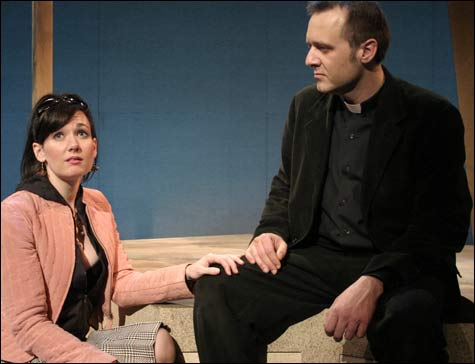
SEE WHAT I WANNA SEE: On the murky border between truth and perception and in a harmonic thicket.
|
Truth is in the eye of the beholder in See What I Wanna See, Michael John LaChiusa’s musically lush riff on stories by Japanese writer Ryunosuke Akutagawa. The musical, which was workshopped at the Williamstown Theatre Festival in 2004 and debuted at New York’s Public Theatre in 2005, transfers two of Akutagawa’s tales to New York’s Central Park while leaving a third in feudal Japan but sets all three on the murky border between truth and perception and in a harmonic thicket where Sondheim meets opera meets post-war jazz meets the minimalist tinkling of Japan. At Lyric Stage Company of Boston, where the piece is in its area premiere (through February 3), it is thrillingly sung and stylishly staged by Stephen Terrell, with musical direction by the exemplary Jonathan Goldberg, who leads an invisible six-person combo. The Achilles heel of the heady theater piece is that LaChiusa does not entirely succeed in translating venerable Japanese conceptions of faith and honor to 20th- and 21st-century New York. Still, the composer/lyricist/librettist’s work is so intelligent, so musically sophisticated, and so emotionally smoldering that it survives its own seemingly fatal flaws. A woman behind me remarked of the show, “It isn’t Oklahoma!” It isn’t, and I’d rather be here.
Each of LaChiusa’s two acts, which tell different stories, opens with a variation on a third tale, “Kesa and Morito,” in which, against a red-lit background, the lovers of the title prepare for a last erotic if murderous encounter. Kabuki meets Bob Fosse in the choreography of the parallel pieces, in which both woman and man experience “what it’s like to be God,” watching from a distance “as the lie becomes the truth and the truth becomes the lie.” This echoes the themes of the two longer pieces, the facts of which would indeed take a hovering deity to delineate. “R-Shomon” removes “In the Grove,” the same story of a rape or seduction and murder or suicide that inspired Akira Kurosawa’s Rashômon, to 1951 New York on the night of the film’s US premiere. “Gloryday,” which is based on Akutagawa’s “The Dragon,” is set in post-9/11 New York where a disillusioned Catholic priest sets in motion a hoax that ultimately restores his faith. The first story is more compelling and familiar, but the Lyric makes a case for the more preposterous second as well. What connects the two, apart from their considerations of actuality and subjectivity, is a seductive musical vocabulary that runs from stately bump-and-grind to jazz syncopation to out-and-out aria to complex, dissonant harmony.
In “R-Shomon” (which takes its title from a missing letter on a theater marquee), a swaggering New York thug catches the eye of a nightclub singer and lures her and her businessman spouse into Central Park in the middle of the night in the hope of having sex with the wife. (Question: what savvy if shady exec, however drunk, would follow a hood into the wood, even in a more innocent 1951?) What follows is then rendered according to contrasting testimony by the criminal, the moviehouse janitor who finds the body, the dishonored wife, and even the dead husband speaking through a medium. The singing by Andrew Schufman, Andrew Giordano, and June Baboian is fine, but Aimee Doherty, strikingly costumed by Rafael Jaen and wearing heels the height of stepladders, deserves special mention for her cocky rendition of the title tune.
Musically shortchanged as the evasive janitor, Brendan McNab gets his chance to shine as the intense, embittered priest of “Gloryday,” whose joke prediction of a Central Park appearance by Jesus Christ draws a loaves-and-fishes-size crowd that includes Oprah and Al Pacino as well as a guilt-crazed CPA living homeless in the park, a failed Hollywood starlet, a glib TV reporter, and the priest’s stolidly atheist aunt, for whom God is “The Greatest Practical Joke” until mortality changes her religious tune. What actually happens depends, once again, on who’s looking at it, but the Lyric singers/actors manage to suggest both gathering momentum and a crowd, and there are some terrific tunes including the infectious “Gloryday” and Giordano’s loopy tour de force for vine-draped CPA, “Central Park.”